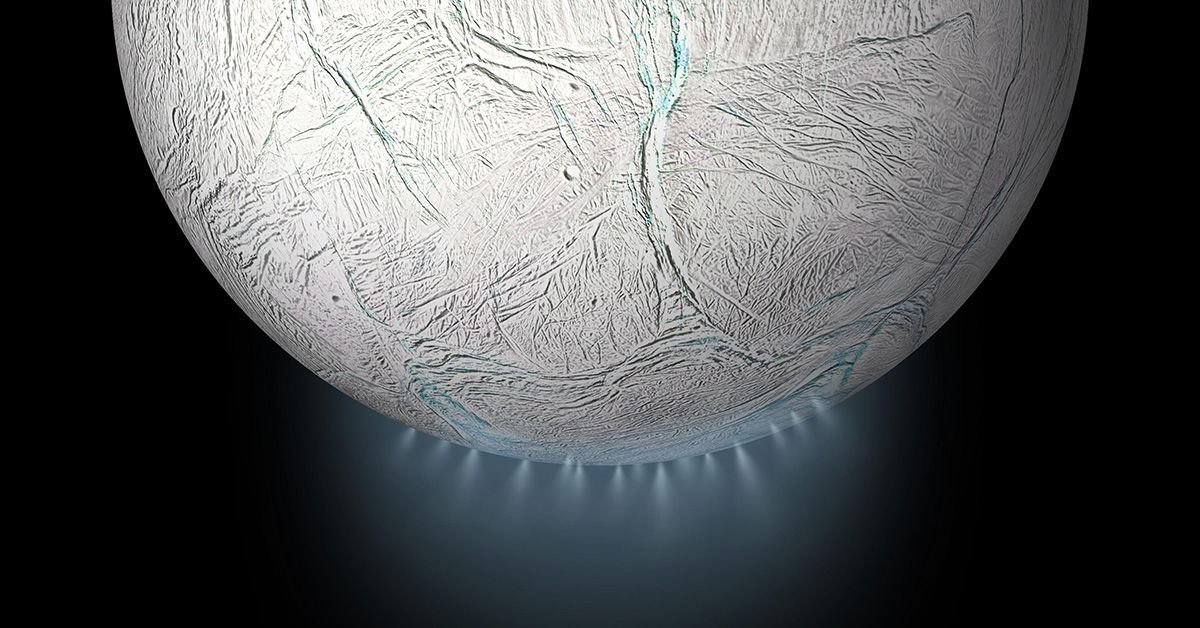Groundbreaking experiments studying the effects of impacts on organic compounds have revealed that future missions designed to search water plumes ejected by Saturn’s icy moon Enceladus for signs of alien life are viable.
Previously, mission planners feared that the impact of the tiny ice grains that make up these massive plumes would become too damaged by the impact with the collection trays, rendering any amino acids or other telltale signs of life unrecognizable. However, these new experiments, which included custom-built tools and techniques, show that organic compounds trapped inside these ice grains could survive these high-speed impacts intact.
Why Enceladus Has Astrobiologists Excited
Astronomers have long been fascinated with Saturn’s icy moon, Enceladus, including the theory that it may have a massive ocean of salt water underneath its icy crust. Then, in 2005, NASA’s Cassini probe detected plumes of ice erupting from the moon’s southern pole at over 400 meters per second (800 mph), offering strong support for a hidden ocean.
Since that discovery, mission planners and amateur enthusiasts alike have proposed flying a probe through those plumes to collect samples of those ice grains and bring them back to Earth for study. If successful, such samples could not only prove the existence of a saltwater ocean but may even contain signs of extraterrestrial life.
Now, a team of researchers from the University of California, San Diego, say that the fear of organic samples becoming too damaged during the collection process is unfounded and that NASA or any of the world’s other space agencies could move ahead with plans for a life hunting mission to Enceladus.
Experiments Support Survivability of Impacts Up To 4.2 km/s
To conduct their experiments, Professor Robert Continetti and his co-workers explained how they built their own customized Aerosol Impact Spectrometer designed to “study collision dynamics of single aerosols and particles at high velocities.”
“This apparatus is the only one of its kind in the world that can select single particles and accelerate or decelerate them to chosen final velocities,” said Professor Continetti. “From several micron diameters down to hundreds of nanometers, in a variety of materials, we’re able to examine particle behavior, such as how they scatter or how their structures change upon impact.”
To simulate the ice grains that make up the plumes of Enceladus, the research team employed a process known as electrospray ionization. This involved pushing water through a needle held at high voltage. The resulting induced charge breaks the water into increasingly smaller and smaller droplets, which the researchers then inject into a vacuum, causing these tiny droplets to freeze.
Finally, the researchers measured the mass and charge of the individual ice grains and then observed closely as the ice grains flew through the spectrometer. Sure enough, their microchannel plate ion detector, which can accurately time the moment of impact down to the nanosecond, revealed exactly what they were hoping for. The organic compounds within the icy grains had survived more or less intact.
“The results showed that amino acids — often called the building blocks of life — can be detected with limited fragmentation up to impact velocities of 4.2 km/s,” they explain.
Missions to Enceladus Could Answer Question of Extraterrestrial Life
Although there are no formal missions to Enceladus on NASA’s current docket, the researchers behind this latest study say their experiments offer strong support that collecting samples from the plumes of Enceladus won’t render them useless, including possible signs of extraterrestrial life.
“To get an idea of what kind of life may be possible in the solar system, you want to know there hasn’t been a lot of molecular fragmentation in the sampled ice grains, so you can get that fingerprint of whatever it is that makes it a self-contained life form,” said Continetti. “Our work shows that this is possible with the ice plumes of Enceladus.”
Christopher Plain is a Science Fiction and Fantasy novelist and Head Science Writer at The Debrief. Follow and connect with him on X, learn about his books at plainfiction.com, or email him directly at christopher@thedebrief.org.

